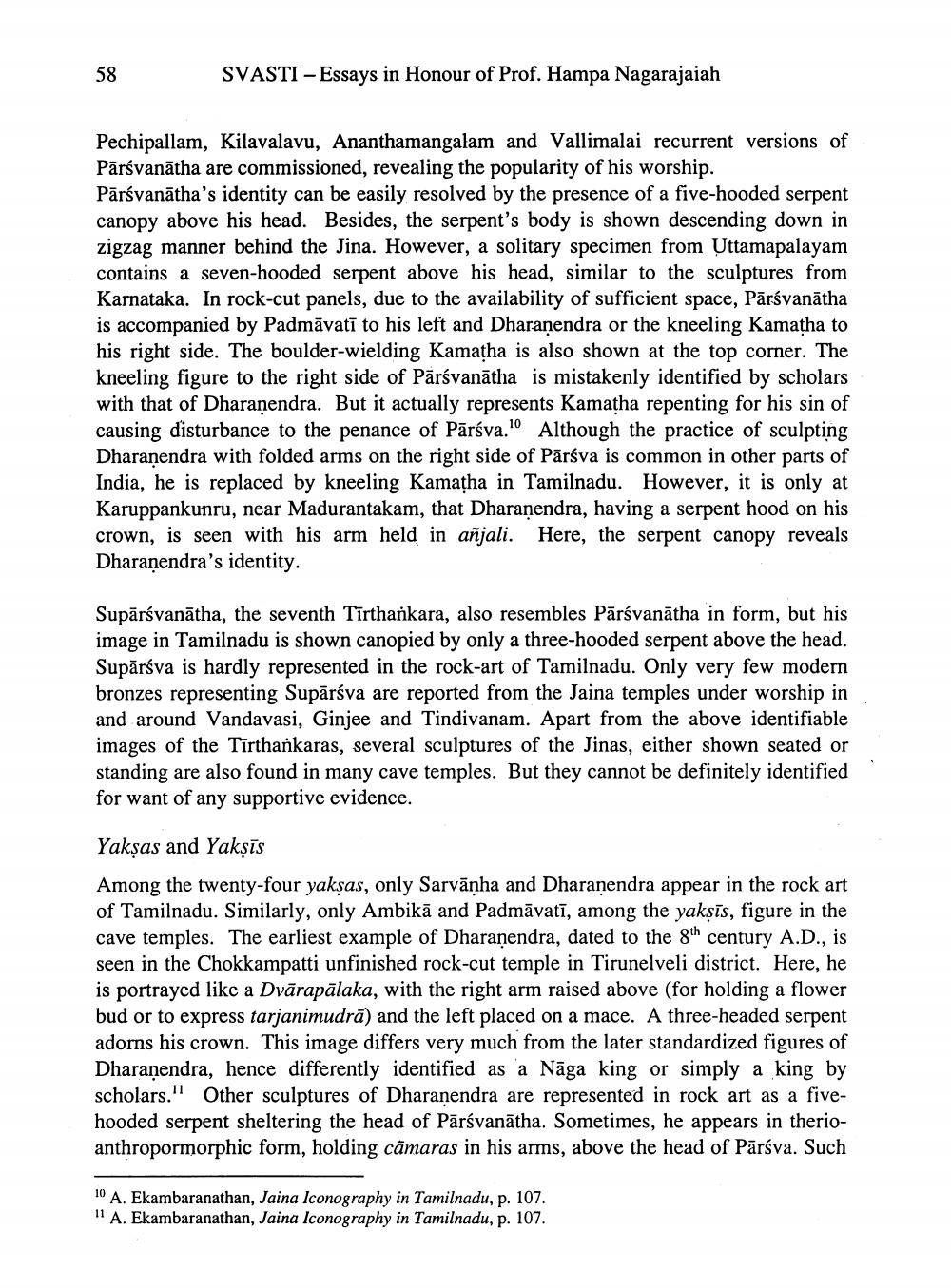________________
SVASTI - Essays in Honour of Prof. Hampa Nagarajaiah
Pechipallam, Kilavalavu, Ananthamangalam and Vallimalai recurrent versions of Pārsvanātha are commissioned, revealing the popularity of his worship. Pārsvanātha's identity can be easily resolved by the presence of a five-hooded serpent canopy above his head. Besides, the serpent's body is shown descending down in zigzag manner behind the Jina. However, a solitary specimen from Uttamapalayam contains a seven-hooded serpent above his head, similar to the sculptures from Karnataka. In rock-cut panels, due to the availability of sufficient space, Pārsvanātha is accompanied by Padmāvatī to his left and Dharanendra or the kneeling Kamatha to his right side. The boulder-wielding Kamatha is also shown at the top corner. The kneeling figure to the right side of Pārsvanātha is mistakenly identified by scholars with that of Dharanendra. But it actually represents Kamatha repenting for his sin of causing disturbance to the penance of Pārsva. Although the practice of sculpting Dharanendra with folded arms on the right side of Pārsva is common in other parts of India, he is replaced by kneeling Kamatha in Tamilnadu. However, it is only at Karuppankunru, near Madurantakam, that Dharanendra, having a serpent hood on his crown, is seen with his arm held in añjali. Here, the serpent canopy reveals Dharanendra's identity.
Supārsvanātha, the seventh Tīrthankara, also resembles Pārsvanātha in form, but his image in Tamilnadu is shown canopied by only a three-hooded serpent above the head. Supārsva is hardly represented in the rock-art of Tamilnadu. Only very few modern bronzes representing Supārśva are reported from the Jaina temples under worship in and around Vandavasi, Ginjee and Tindivanam. Apart from the above identifiable images of the Tīrthankaras, several sculptures of the Jinas, either shown seated or standing are also found in many cave temples. But they cannot be definitely identified for want of any supportive evidence.
Yakşas and Yakṣīs Among the twenty-four yakşas, only Sarvāṇha and Dharanendra appear in the rock art of Tamilnadu. Similarly, only Ambikā and Padmāvatī, among the yakṣīs, figure in the cave temples. The earliest example of Dharanendra, dated to the gth century A.D., is seen in the Chokkampatti unfinished rock-cut temple in Tirunelveli district. Here, he is portrayed like a Dvārapālaka, with the right arm raised above (for holding a flower bud or to express tarjanimudrā) and the left placed on a mace. A three-headed serpent adorns his crown. This image differs very much from the later standardized figures of Dharanendra, hence differently identified as a Nāga king or simply a king by scholars." Other sculptures of Dharanendra are represented in rock art as a fivehooded serpent sheltering the head of Pārsvanātha. Sometimes, he appears in therioanthropormorphic form, holding cāmaras in his arms, above the head of Pārsva. Such
10 A. Ekambaranathan, Jaina Iconography in Tamilnadu, p. 107. "1 A. Ekambaranathan, Jaina Iconography in Tamilnadu, p. 107.




